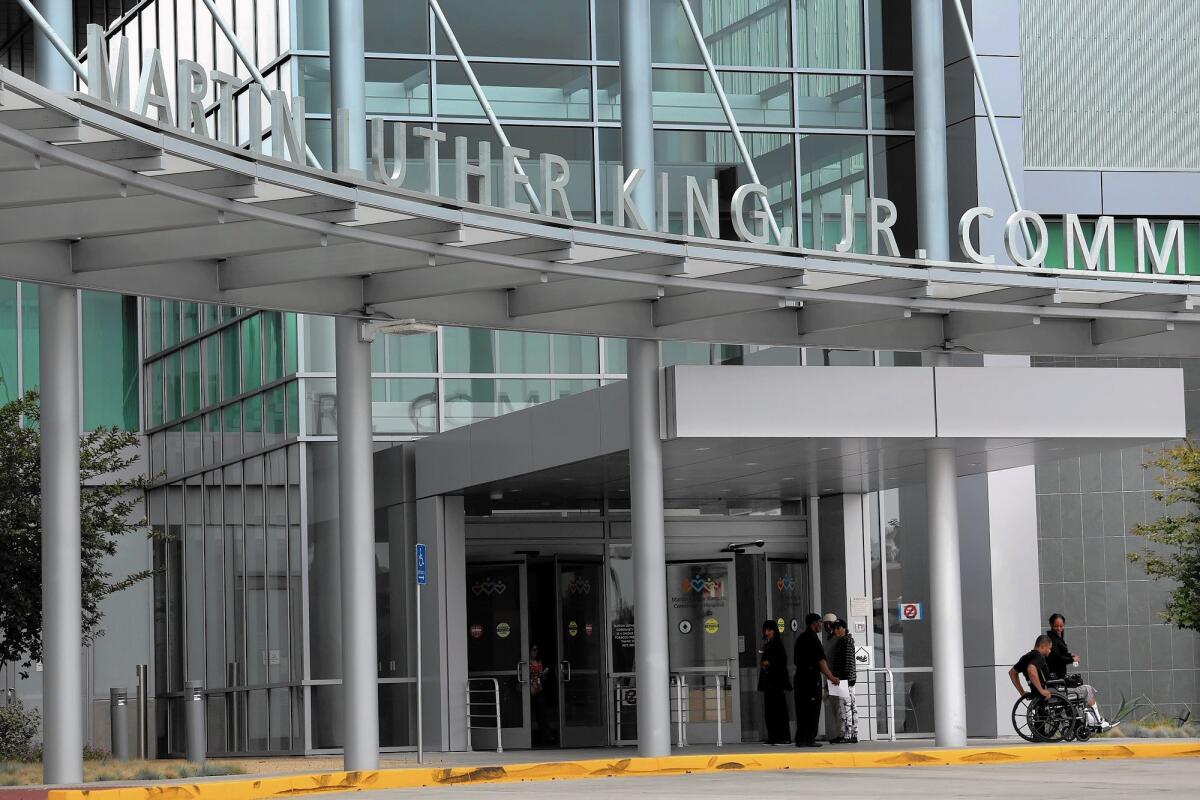How the new King hospital hopes to put its ‘Killer King’ image ‘far behind’

- Share via
At the old King/Drew Medical Center, guards used Tasers on psychiatric patients. Trauma surgeons mistakenly slit the throat of an 18-year-old shooting victim and a woman contracted HIV after she was infused with virus-infected blood.
The public facility was forced to shut down in 2007, in large part because of serious breakdowns in patient care. Now a new hospital, known as Martin Luther King Jr. Community Hospital, has opened in its place and administrators say that they aim for it to be one of the best facilities on the West Coast.
“The notion of ‘Killer King’ will be left far behind us,” said Los Angeles County Supervisor Mark Ridley-Thomas, who helped relaunch the Willowbrook hospital that began treating patients this summer.
Experts agree that the new facility has adopted some of the best standards and technologies in the healthcare industry, capitalizing on a unique opportunity to design a hospital from the ground up. But they say that only time will tell whether these new practices will translate into consistent, top-tier medical care.
On the wall in each patient’s room at the hospital is a whiteboard labeled “Care Team.” It lists the names of the doctor, nurse and social worker who are assigned to patients as soon as they are admitted to the 131-bed hospital.
Each team has a manager — typically a nurse — who oversees the patient’s care and experience at the hospital. Managers talk to family members and try to work out details that physicians don’t always have time to pay attention to, said Dr. John Fisher, the hospital’s chief medical officer.
For instance, if a doctor calls in a prescription for a patient who has left the hospital, the manager will check on whether the family has an easy way to get to the pharmacy. If there is a problem, the manager will find a closer drugstore. Otherwise, a nonmedical issue such as transportation could hinder a patient’s recovery, Fisher said.
Hospitals across the country have recently increased efforts to improve patient recoveries and reduce the number who need to return soon after being discharged. That’s because hospitals began to be penalized under the Affordable Care Act three years ago if they had high readmission rates.
Though patients sometimes need to go back to the hospital shortly after discharge, many are unnecessarily readmitted, driving up medical costs. Studies show that reducing complications during patients’ initial visits, improving discharge instructions and coordinating with patients’ primary care doctors outside the hospital can help reduce those rates.
That’s why hospitals are investing in care coordinators who look for potential problems, such as whether patients have remembered to schedule follow-up appointments with doctors, said Jennifer Bayer, vice president for external affairs for the Hospital Assn. of Southern California.
“It definitely is the wave of the future,” she said.
King Community Hospital’s approach is one of the industry’s more comprehensive, experts say, because care coordinators target each patient instead of just those who are high-risk.
Additionally, the way the hospital’s teams operate is unusual, said Steve Valentine, president of Camden Group, a national healthcare consulting firm based in El Segundo. The firm worked with the hospital early in its development.
Valentine said physicians and nurses do morning rounds together, which is more time-intensive and requires more resources than each provider working separately.
That model is accepted as a best practice in the healthcare industry, he said, because it leads to better communication and care. King Community Hospital rises to the top quartile of facilities in the Los Angeles region simply by adopting it, he said.
“Do all hospitals do it? Absolutely not,” Valentine said.
NEWSLETTER: Get the day’s top headlines from Times Editor Davan Maharaj >>
Still, the hospital has a tough reputation to shake. The nickname “Killer King” stuck after it failed several inspections and closed eight years ago.
South Los Angeles resident Daniel Bonilla, 59, said he’s never been to King Community Hospital but knew of its checkered history. He was buying groceries on a recent weekday at a shopping plaza across the street.
He goes to a private nonprofit JWCH Institute clinic in Bell Gardens for checkups, he said. He hasn’t had to visit a hospital recently but doesn’t think he would choose to go to King Community Hospital. “They don’t take care of their patients well,” he said.
Hospital administrators say they have carefully vetted physicians — many of whom also work at UCLA medical facilities — and staff, and chosen people who are dedicated to the hospital’s mission for improving patient care. However, that isn’t because they’re trying to make up for King/Drew’s troubled past, said Jim Lott, the hospital’s vice president for strategy and business development.
“This is something every hospital tries to do,” he said. “We remember the past, but it has nothing to do with it.”
Indeed, not only are hospital finances tied to keeping readmission rates low under the Affordable Care Act, they are also linked to patient satisfaction levels. Hospitals with the highest scores can get bonus payments from Medicare. King Community Hospital’s case managers — and other more simple features, such as futons in each room for family members to sleep on — will probably increase those scores, experts said.
“It just so happens that it solves the old problems,” Lott said.
Experts say it is too early to judge how the hospital is performing with these new standards.
King Community Hospital administrators say that the relaunch was a rare chance to build from the ground up and do it the right way.
They were able to install the latest technology while older hospitals often struggle to keep up. For many providers, for example, it’s been a costly and time-consuming undertaking to switch from paper to electronic medical records. King Community Hospital was designed with a fully electronic record system, and the entire hospital is nearly paperless.
“From a technology standpoint, building a hospital has huge advantages compared to trying to retrofit a hospital that was built 30 or 40 years ago,” said Erica Mobley with Leapfrog Group, an employer-backed nonprofit group focused on healthcare quality.
The hospital also has “smart” devices, such as beds that can weigh patients and take other diagnostics and transmit them directly into a digital medical record.
While older hospitals try to figure out how to make older devices communicate with one another, King Community Hospital was able to invest in an integrated system that was created with that in mind, Valentine said. He said using such a system should cut down on medical errors and also lead to more expeditious care.
Bayer said she hadn’t seen those smart devices elsewhere.
“They’re certainly bringing a lot of state-of-the-art technology to a community that’s been largely underserved, and for that part of L.A., that should be very, very exciting,” she said.
soumya.karlamangla@latimes.com
Follow @skarlamangla on Twitter for more health news.
ALSO
LAPD gets $1 million for body cameras from Department of Justice
L.A. could impose new rules for pot shops paying city taxes
Gov. Jerry Brown requests national disaster declaration from Obama for state fires
More to Read
Sign up for Essential California
The most important California stories and recommendations in your inbox every morning.
You may occasionally receive promotional content from the Los Angeles Times.














